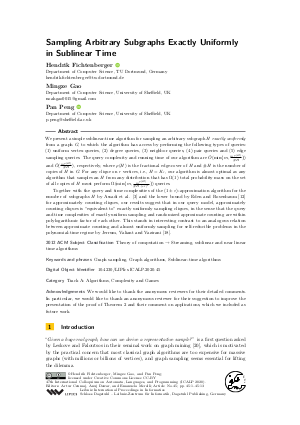@InProceedings{fichtenberger_et_al:LIPIcs.ICALP.2020.45,
author = {Fichtenberger, Hendrik and Gao, Mingze and Peng, Pan},
title = {{Sampling Arbitrary Subgraphs Exactly Uniformly in Sublinear Time}},
booktitle = {47th International Colloquium on Automata, Languages, and Programming (ICALP 2020)},
pages = {45:1--45:13},
series = {Leibniz International Proceedings in Informatics (LIPIcs)},
ISBN = {978-3-95977-138-2},
ISSN = {1868-8969},
year = {2020},
volume = {168},
editor = {Czumaj, Artur and Dawar, Anuj and Merelli, Emanuela},
publisher = {Schloss Dagstuhl -- Leibniz-Zentrum f{\"u}r Informatik},
address = {Dagstuhl, Germany},
URL = {https://drops.dagstuhl.de/entities/document/10.4230/LIPIcs.ICALP.2020.45},
URN = {urn:nbn:de:0030-drops-124526},
doi = {10.4230/LIPIcs.ICALP.2020.45},
annote = {Keywords: Graph sampling, Graph algorithms, Sublinear-time algorithms}
}

 Creative Commons Attribution 3.0 Unported license
Creative Commons Attribution 3.0 Unported license

